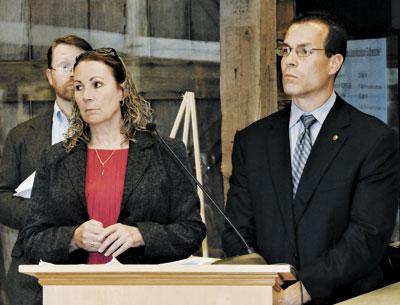Army Corps Offers One Montauk Option

After months of waiting to hear what the Army Corps of Engineers would offer to do for the town to reinforce the downtown Montauk beach at full federal expense under a Hurricane Sandy recovery program, East Hampton officials and residents learned yesterday that only one option has been deemed financially viable at this juncture: reinforcing the dunes along the shoreline using geotextile bags filled with sand.
The project would cost $6 million, said Steve Couch of the Army Corps, and would involve placing 14,000 geotextile bags along 3,100 feet of downtown shoreline and trucking in 45,000 cubic yards of sand to cover them. The town would be responsible for ensuring that they remain covered.
According to a proposed timeline, for the work to begin in December, the Army Corps and the state’s Department of Environmental Conservation, which would be involved in administration of the project, would need a local sponsor — the town or county — to sign on within the next few weeks.
Under the decades-long federal Fire Island to Montauk Point reformulation study, a number of alternatives were under review for Montauk beach protection when Sandy hit in October 2012 and exacerbated the erosion on downtown beaches as well as elsewhere in the town.
Downtown Montauk, as well as Fire Island, became eligible for an emergency stabilization project, to be fast-tracked and paid for entirely with federal money.
Last fall, the Army Corps proposed alternatives for review that included rebuilding and widening the beach with sand only, or rebuilding and adding a stone revetment or armored dune; relocating buildings and rebuilding the beach; creating a widened “feeder beach” that would send sand downdrift into eroded areas, and filling in the beach and building groins extending into the sea. The groin option, the Corps said, was presented for comparison only and was not seriously considered.
Town officials requested that the agency pursue evaluation of the beach rebuilding options, with and without an armored dune, and to also evaluate a beach reconstruction project using a dune reinforced with geotextile tubes.
Installing a revetment, groin, or hard structure was ruled out pursuant to town coastal policy, which prohibits suchtructures along the oceanfront.
The Army Corps analyzed potential projects according to their costs and benefits.
The costs to complete a project that would adequately protect the downtown buildings near the beach, without using hard structures such as a rock wall or reinforced dune, would be “extremely high,” the agency concluded. However, the Corps conceded that there is potential for a high amount of damage in the area near the downtown beach.
Because of the location of buildings along the dune line, a new dune would have to be constructed seaward of the buildings, and the beach would have to be extended, requiring a large amount of sand used as fill. A high volume of fill would need to be added on a frequent basis to maintain the beach, the Corps said.
The cost of that would exceed the benefits, according to the Corps’ analysis formula, which considers the value of reduced damages to buildings and recreation benefits.
In a March memo to the town, the Army Corps said that the emergency beach stabilization project is considered separate from the overall scope of work that could take place under the Fire Island to Montauk reformulation study.
As a result, the Corps said, any first-round project that requires mobilization of a dredge is not economically viable.
However, additional work beyond the emergency stabilization project could take place over the longer term under the Fire Island to Montauk effort. An alternative, scaled-down plan, which the Corps says is “economically justified,” calls for the periodic addition of sand to the beach to offset long-term sand loss from natural erosion processes.
